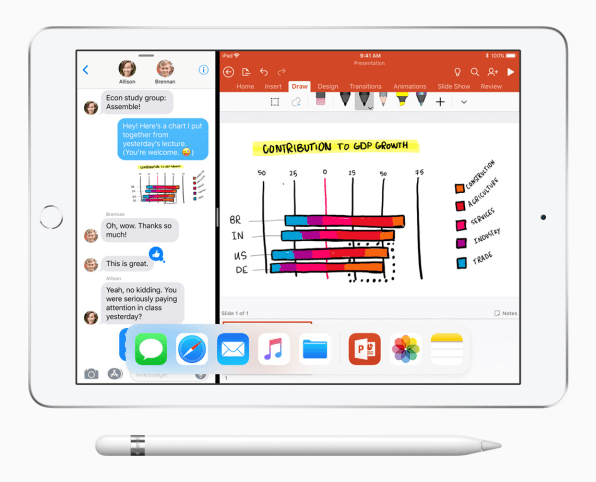This morning, Apple took a shot at Google’s dominance of the education market with its announcement of a new low-priced iPad and a series of new and upgraded software for both teachers and students. The question is whether or not Apple sweetened the deal enough for educators to regain some of the ground it’s already ceded to Google and the Chromebook.
Many schools, especially ones in less affluent districts, have been attracted by Google’s free apps and inexpensive Chromebooks. Google first offered schools a suite of Google Docs collaboration and productivity apps, then provided an affordable hardware element with the low-cost laptops.
iPad, Still $299
Looking at the hardware after today’s announcement, school administrators may be deciding between Chromebook laptops that cost around $300 and iPad tablets that cost $299. That’s pretty much the same deal as before (9.7-inch iPads were reduced to $299 for schools last year), except that now the iPad supports a Pencil stylus that costs another $80. And the new iPad has a faster chip, a better display, and some other normal upgrades.
Apple may still have a hard time convincing budget-strapped schools to choose iPads over Chromebooks.
“While the new Apple introductions are a good step forward, they ignore the basic fact that iPads—especially with the addition of the Pencil—are still pretty expensive for most schools,” said TECHnalysis Research analyst Bob O’Donnell in an email to Fast Company on Tuesday.
IDC analyst Tom Mainelli said something similar. “My biggest concern with today’s announcement is around hardware price,” he said in an email to Fast Company. In the lead up to today’s event, many people had speculated that Apple would announce an iPad with a more aggressive price drop–at least for educators.
Mainelli points out that Apple began winning back share in the education market (and returning to growth in the iPad business, generally) after it reduced the price of the 9.7-inch iPad to $329 last year ($299 for schools). Apple itself had indicated it would like to get the price point down to $259.

“They are likely to maintain that momentum with this new product, which brings better performance as well as new features (including support for Apple Pencil),” Mainelli said. “I think many schools would probably skip this version of the iPad if they could get last year’s version for less than $299 (say $249 or less),” he added.
When looked at as a school-wide initiative, iPad costs could quickly add up. “I can see Apple improving its position, but I don’t see many wholesale school-wide trade outs of Chromebooks or Windows PCs for the new iPads,” said Moor Insights & Strategy principal analyst Patrick Moorhead. “I can see some departments adopting the new iPads for some creative applications in AR, VR, and coding.”
An Ecosystem
Over the long-term it might be the software Apple announced in Chicago that makes the difference. With the new authoring, class management, and creative apps, the company is putting forward a more complete ecosystem for education.
“Apple now has a solution to manage the classroom, but also the work, so teachers can see in an effective way if the apps they are using give good returns,” said Creative Strategies analyst Carolina Milanesi in a message to Fast Company. “Most importantly it t really feels like Apple has a solution rather than a series of features.”
Today’s announcements could be the start of a more gradual repositioning of the Apple ecosystem offering for schools, says Mukul Krishna, global practice head of digital media at Frost & Sullivan. It may start with schools that can afford to buy a premium Apple experience. “They are looking at chipping away at the inroads Google has made in affluent schools,” Krishna said.
New Management Tools
Apple wisely addressed one of the most important issues for administrators and teachers–device management and security. The new School Manager gives school IT people one central web portal where they can keep track of users, devices, and content. Importantly, students can now use a unique Apple ID to log onto any iPad managed by the school.
The device management component has long been one of the strong suits of the Google ecosystem. “The new software tools are important for helping to manage devices in the classroom,” says TECHnalysis’s O’Donnell, “but it still feels like Apple is playing catch-up with Google’s Chromebook offerings and management tools.”
Long Game
Frost & Sullivan’s Krishna points out that education tech was a $17.1 billion market worldwide last year–not very big compared to many of Apple’s other businesses. But, he says, there’s much more at stake than just iPad sales.
Earlier on in Apple’s history, the company was the first to show many users the huge improvement from DOS environments to colorful graphical user interfaces, Krishna said. That positive experience, he said, created many lifetime Apple customers.
That’s part of the reason schools are so important to Apple now. It wants to get people used to the Apple Way early in life. “You’ve got to grab them while you can–before they get out into the world and become influencers.”
Krishna explains that when students leave the education system and enter the workforce, they often have to adjust to a whole new ecosystem–often a Microsoft ecosystem. “An Apple computer is considered a rogue machine on many enterprise networks,” he said. Apple would eventually like to change that dynamic, and it’s working with partners like IBM and SAP to begin establishing the Apple ecosystem in the enterprise. But it will take years. The people most likely to witness that shift tomorrow are sitting in grade school classrooms today. Krishna believes that for Apple, schools are just the start of a “very, very long-term plan.”
(55)